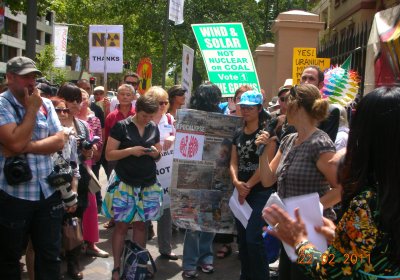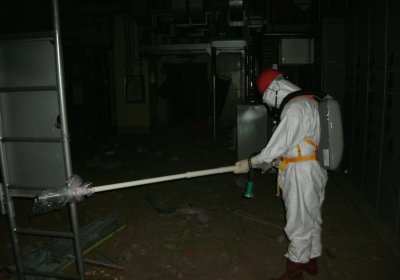Events were held around the country on March 11 to mark three years since an earthquake and subsequent tsunami laid waste to the north-east coast of Japan. The earthquake and tsunami disasters killed 18,600 people and about 2700 bodies have never been recovered.
The disaster damaged the Fukushima nuclear power plant, whose cooling systems failed, leading to a series of explosions and catastrophic meltdowns in three reactor cores. More than 150,000 people who were forced to evacuate the area are still unable to return to their homes in the Fukushima region.
Japan
“Forgetting Fukushima makes it more likely that such a nuclear disaster could happen elsewhere,” said Tatsuko Okawara, one of the hundreds of thousands of victims of the Fukushima accident that began on March 11, 2011.
The nuclear industry, however, is trying its hardest to make us forget. It is downplaying the impacts of the accident, ignoring the fact that the Fukushima reactors are still not under control and claiming that lessons have been learned. Nothing is further from the truth.
A second storage pool was leaking highly radioactive water at the crisis-stricken Fukushima Dai-chi nuclear plant on April 7, operator Tepco said.
About 120 tonnes of radioactive water breached the inner lining of one underground storage pool on April 5, with concerns that some may have leaked into the soil.
Tepco is moving the remaining 13,000 tonnes of water in that tank to other pools, but said the April 7 leak was not large enough to warrant doing the same.
Fallout From Fukushima
By Richard Broinowski
Scribe, 2012
273 pages , $27.95 (pb)
The Fukushima nuclear disaster in Japan last year was no accident, says Richard Broinowski in Fallout from Fukushima.
Sitting a nuclear reactor on an “active geological fault line where two of the earth’s tectonic plates collide” was courting catastrophe from an earthquake and tsunami like the one that duly hit the Pacific in March last year.
Last week I had a dream that my house in the western part of Tokyo was shaking violently around me. Then I woke up and discovered it wasn’t a dream at all. It was a 5.3 magnitude earthquake with its epicentre in nearby Saitama.
It was the second earthquake I had felt in less than a week following the March 11 anniversary of Japan's earthquake and tsunami disaster. It was a frightening and potent reminder of exactly why it is so important to rid Japan of nuclear power plants.
The All Japan 3.11 Action Committee released the statement that is abridged below below on March 11.
* * *
March 11 marks the one year anniversary of the TEPCO Fukushima Daiichi nuclear reactor accident. Many people were forced to evacuate and still continue to live under hardship without enough compensation.
Despite the fact that an rising number of people in Japan (up to 70%) want to end nuclear power, the Japanese government is obsessively promoting it.
Tens of thousands filled the square as the echoes of the speaker at the podium boomed through huge speakers. Some came in anger, others in grief, but all agreed: it was time for a change. Many carried banners, others carried drums; some had taken their children out of school to attend.
No, this wasn't Tahrir Square; it was Tokyo, Japan, on a chilly Monday last September.
Ever since the devastating earthquake and tsunami that crippled the Fukushima Daiichi nuclear power station, Japanese civil society has become less, well, polite.
A snap rally was held outside NSW parliament house on February 22 to protest a bill proposed by Premier Barry O’Farrell to lift the 26-year moratorium on uranium exploration in NSW. The Nature Conservation Council and Beyond Nuclear Initiative organised the rally.
The moratorium on nuclear exploration in NSW began as a bipartisan agreement between Liberal and Labor parties after an investigation found that the effects of mining would be too dangerous.
Five anti-nuclear activists travelled from Australia to attend the Global Conference for a Nuclear Power Free World held in the Japanese port city of Yokohama, over January 14–15.
The conference was attended by 11,500 people over the two days including 100 international participants from 30 countries.
About 40 activists, many from conservation group Forest Rescue and anti-whaling campaigners Sea Shepherd, gathered outside the Japanese embassy in Perth on January 9. They were demanding the release of three Australian men detained on a Japanese whaling ship and for an end to the slaughter of whales.
The men had been held on board the Shonan Maru II since the early morning of January 8, when they boarded the vessel off Fremantle's coast to protest the presence of a whaling fleet in Australian waters.
More than 65,000 people in cities and towns all over Japan marched on June 11 to mark three months since Fukushima nuclear disaster. Marchers called for an end to nuclear power.
In Tokyo, separate marches took off from different routes through the city before assembling in front of Shinjuku station.
The largest action, a “sound-demo” called by the Shiroto no Ran (“Amateur Riot”) network attracted thousands of young people. They marched through the city accompanied by sound-trucks plying a variety of musical styles, from punk to folk to techno.
Three months after the earthquake and tsunami that triggered a nuclear disaster in Japan, new radiation "hot spots" may require the evacuation of more areas further from the damaged Fukushima Daiichi nuclear power facility.
- Previous page
- Page 3
- Next page







